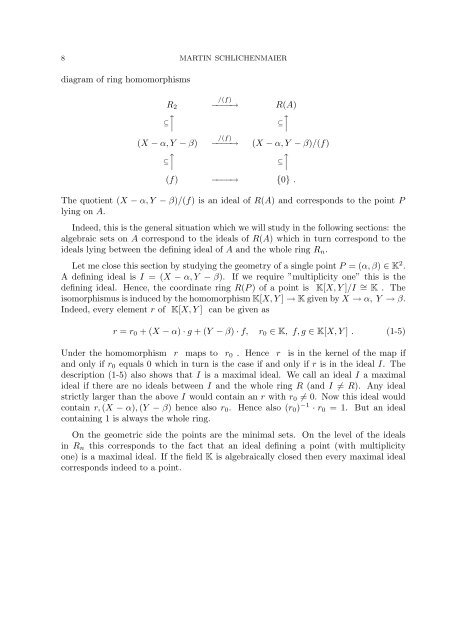Mannheimer Manuskripte 177 gk-mp-9403/3 SOME CONCEPTS OF ...
Mannheimer Manuskripte 177 gk-mp-9403/3 SOME CONCEPTS OF ...
Mannheimer Manuskripte 177 gk-mp-9403/3 SOME CONCEPTS OF ...
- No tags were found...
Create successful ePaper yourself
Turn your PDF publications into a flip-book with our unique Google optimized e-Paper software.
8 MARTIN SCHLICHENMAIERdiagram of ring homomorphisms⊆R 2↑⏐(X − α,Y − β)↑⊆⏐/(f)−−−−→/(f)−−−−→R(A)↑⊆⏐(X − α,Y − β)/(f)↑⊆⏐(f) −−−−→ {0} .The quotient (X − α,Y − β)/(f) is an ideal of R(A) and corresponds to the point Plying on A.Indeed, this is the general situation which we will study in the following sections: thealgebraic sets on A correspond to the ideals of R(A) which in turn correspond to theideals lying between the defining ideal of A and the whole ring R n .Let me close this section by studying the geometry of a single point P = (α,β) ∈ K 2 .A defining ideal is I = (X − α,Y − β). If we require ”multiplicity one” this is thedefining ideal. Hence, the coordinate ring R(P) of a point is K[X,Y ]/I ∼ = K . Theisomorphismus is induced by the homomorphism K[X,Y ] → K given by X → α, Y → β.Indeed, every element r of K[X,Y ] can be given asr = r 0 + (X − α) · g + (Y − β) · f, r 0 ∈ K, f,g ∈ K[X,Y ] . (1-5)Under the homomorphism r maps to r 0 . Hence r is in the kernel of the map ifand only if r 0 equals 0 which in turn is the case if and only if r is in the ideal I. Thedescription (1-5) also shows that I is a maximal ideal. We call an ideal I a maximalideal if there are no ideals between I and the whole ring R (and I ≠ R). Any idealstrictly larger than the above I would contain an r with r 0 ≠ 0. Now this ideal wouldcontain r,(X − α),(Y − β) hence also r 0 . Hence also (r 0 ) −1 · r 0 = 1. But an idealcontaining 1 is always the whole ring.On the geometric side the points are the minimal sets. On the level of the idealsin R n this corresponds to the fact that an ideal defining a point (with multiplicityone) is a maximal ideal. If the field K is algebraically closed then every maximal idealcorresponds indeed to a point.
















